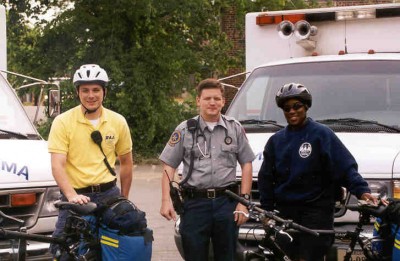In the US, bicycling is still seen as a form of recreation. As such, it is not taken seriously as either a legitimate form of transportation or a vital part of American society. In many cases, cyclists blend into a crowd so well that people are unaware of them.
Despite the commonly held belief that cycling is a “childish” pursuit, bicycling heroes exist. But, because they get so little coverage in the media, most Americans remain unaware of their presence – or at least of their importance.
Behind the scenes, at large events and other places where crowds gather, is a group of dedicated cyclists whose mission is to help those in need – and when necessary, to save lives. These cyclists are often referred to as “bike medics.”
In a recent article in Medical News Today, Bike Medics: Saving Lives – And Money, Catharine Paddock, PhD described the role of bike medics in different countries. With respect to the US she wrote:
“In the United States, cycle responders are more often referred to as EMS (emergency medical service) bikers, and classed as part of emergency and patrol cycling services that also include police, search and rescue, and in some cases, fire.”
By way of history, she mentioned that bike medics first appeared in the US in the 1980s and offered the following:
“In the 1990s, official EMS cycling units began to emerge throughout the US, and also in Canada. While the predominant use appears still to be at large events, more and more permanent units are now deployed in a variety of locations, such as tourist areas, amusement parks, sport arenas, college campuses, airports, train stations and other transport centres.”
After reading her article, I did some research and learned that bike medic units exist in most major cities throughout the US. Although I had seen bike medics occasionally at special events, I had no clue about what their training entailed or what medical skills they possessed. Initially, I thought that they provided first aid treatment to sick or injured people in large crowds. I was surprised when I discovered what they did.
The Troy Fire Department’s Bicycle Paramedic Program (located in Troy, Ohio) provides a good description of their program and information on what they carry to an emergency and what they’re capable of treating.
“The Bike program is intended to arrive on the scene rapidly, assess, and stabilize the patient prior to the arrival of the ambulance. Therefore carrying only the drugs that could be used in the first 5-8 minutes of our arrival is necessary. We carry the first line of drugs for chest pain, cardiac arrest, respiratory problems, diabetic, seizures or anaphylaxis.”
Their response times are impressive:
“Our response times vary by event. For some events, the times can be as short as 15-30 seconds. For parades or running races, the times can be up to 2-3 minutes.”
They go on to describe the training required to become a member of the bike medic unit:
“All members of the bicycle unit are required to attend a 32-hour cyclist school. We follow the International Police Mountain Bike Association (IPMBA) standards for training. IPMBA has had a 32-hour EMS Cyclist course since 1997. Our program coordinator attended the first IPMBA EMS Cyclist course at the Nashville conference. Our department has one IPMBA EMS Cyclist Instructor Trainer and one IPMBA EMS Cyclist Instructor.”
The City of Richmond, Virginia formed a Bike Medic Team (represented in the photo above) in response to large-scale events held in parks or other large areas filled with crowds.
“Approximately 25 paramedics make up the squad, which uses professional-grade police bikes equipped with mobile cardiac defibrillators, intubation kits, advanced life support drugs and other medical supplies. The bikes enable paramedics to respond to the scene much more quickly than they could in an ambulance. The Bike Medic team has proven to be extremely popular with community members, who frequently request their presence at events. Respiratory and cardiac calls are the ones most commonly treated by the bike medics, who must pass physical training and riding tests to earn a spot on the unit.”
These unsung heroes provide yet another example of the value of bicycles as a means of transportation – and they embody an environmentally friendly method of delivering public services. Unlike ambulances, or other motor vehicles, bicycles can cover large distances on terrain inaccessible to cars – such as mountain paths in parks – and they can agilely maneuver in places where large numbers of people are milling about.
In short, not only do bicycles provide a healthy and practical way to travel, but they provide the means for saving lives that might otherwise be lost.




